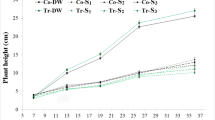Abstract—The purpose of this study was to experimentally assess the effectiveness of using electrolyzed water to suppress the activity and contain the spread of phytopathogens when growing tomato seedlings during the off-season. The object of research was artificially cultivated phytocenoses of tomato seedlings. Qualitative and quantitative laws characterizing the dependence of phytopathogenic microflora distribution in tomato seedlings during the electrolyzed water treatment, as well as methods and operating parameters after electrolyzed water application, were studied. Quantitative assessment of disease control in tomato seedlings was made taking into account the species composition of phytopathogens. The effectiveness of electrolyzed water application for suppressing the activity of the causative agents of Fusarium root rot (Fusarium oxysporum f. sp. radicisly-copersici), Septoria lycopersici, and tomato root rot (Pythium debaryanum and P. ultimum) has been confirmed. It was found that pathogens—causative agents of Fusarium root rot—are the most sensitive to treatments with catholite –600 mV; their distribution is also well controlled by anolyte +800 mV. Such parameters of electrochemical water treatment turned out to be optimal for disinfecting soil in monotechnology, which ensured a reduction in the total number of affected plants by 34.8–63.6%. The use of electric water with the microbiological drug Bisolbisan under alternate spraying patterns with a 1-day interval has reduced the number of selected plants by 44.4–66.6%. This method has also been proven to be the most effective and ensured the containment of distribution of listed diseases at the level of 0.8–2.0%.




Similar content being viewed by others
REFERENCES
Demidenko, G.A., Agroecological assessment of the use of specialized soils for growing tomato seedlings, Vestn. Krasnoyarsk. Gos. Agrar. Univ., 2017, no. 4, pp. 11–17.
Soromotina, T.V., The effect of seedling age and planting density on the productivity of determinant tomatos, Permsk. Agrar. Vestn., 2017, no. 2, pp. 71–76.
Abakumova, A.S., Zimina, Zh.A., Arslanova, R.A., and Kurmanalieva, R.I., Agrotechnology of growing indeterminate tomatoes in the phytotron-greenhouse complex, Tekhnol. Pishch. Pererab. Prom-sti. APK, Prod. Zdorov. Pitaniya, 2014, no. 1, pp. 18–21.
Palastrova, O.A., Tomato diseases and the rationale for measures to fight them in the conditions of Kurgan oblast, Vestn. Kurgansk. Gos. S-kh. Akad., 2018, no. 4, pp. 22–29.
Ignatov, A.N., Chelidze, G.G., and Vorob’eva, K.S., Risks of the spread of new viral and bacterial diseases of vegetable crops through greenhouses in the Russian Federation, Kartofel Ovoshchi, 2019, no. 4, pp. 18–21.
Bairambekov, Sh.B., Korneva, O.G., and Polyakova, E.V., Main diseases of vegetable and melon crops in the Lower Volga region, Zashch. Karantin Rast., 2013, no. 8, pp. 46–49.
Antonenko, A.M., Vavrinevych, O.P., Korshun, M.M., and Omelchuk, S.T., Hygienic assessment of the effects of pesticides application on adult population morbidity with thyroid gland diseases, Wiadomosci Lek., 2018, vol. 71, no. 2, pp. 353–357.
Grech, A., Brochot, C., Bois, F.Y., Beaudouin, R., Quignot, N., and Dorne, J.-L., Toxicokinetic models and related tools in environmental risk assessment of chemicals, Sci. Total Environ., 2017, vol. 578, pp. 1–15.
Korobeinikova, O.V., Fitosporin-M on tomato, Kartofel Ovoshchi, 2016, no. 6, pp. 16–17.
Matyjaszczyk, E., Plant protection means used in organic farming throughout the European Union, Pest Manage. Sci., 2018, vol. 74, no. 3, pp. 505–510.
Semenenko, S.Ya., Belitskaya, M.N., and Likholetov, S.M., Phytosanitary improvement of grain and vegetable crops using electrochemically activated water, Usp. Sovrem. Estestvozn., 2013, no. 1, pp. 78–82.
Chushkina, E.I., Semenenko, S.Ya., Lytov, M.N., and Chushkin, A.N., The mechanism of biological action and the experience of using electrochemically activated aqueous media in agriculture, Nauchn. Zh. Ross. NII Probl. Melior., 2015, no. 4.
Al-Qadiri, H.M., Smith, S., Sielaff, A.C., Govindan, B.N., Ziyaina, M., Al-Alami, N., and Rasco, B., Bactericidal activity of neutral electrolyzed water against Bacillus cereus and Clostridium perfringens in cell suspensions and artificially inoculated onto the surface of selected fresh produce and polypropylene cutting boards, Food Control, 2019, vol. 96, pp. 212–218. https://doi.org/10.1016/j.foodcont.2018.09.019
Feliziani, E., Lichter, A., Smilanick, J.L., and Ippolito, A., Disinfecting agents for controlling fruit and vegetable diseases after harvest, Postharv. Biol. Technol., 2016, vol. 122, pp. 53–69. https://doi.org/10.1016/j.postharvbio.2016.04.016
Pinto, L., Baruzzi, F., and Ippolito, A., Recent advances to control spoilage micro-organisms in washing water of fruits and vegetables: The use of electrolyzed water, Acta Hortic., 2016, vol. 1144, pp. 379–384. https://doi.org/10.17660/ActaHortic.2016.1141.72
Author information
Authors and Affiliations
Corresponding author
Ethics declarations
The authors declare that they have no conflict of interest. This article does not contain any studies involving animals or human participants performed by any of the authors.
Additional information
Translated by T. Borisova
About this article
Cite this article
Semenenko, S.Y., Lytov, M.N., Chushkina, E.I. et al. Application of Electrolyzed Water in the Context of Disease Control for Tomato Seedlings. Russ. Agricult. Sci. 46, 241–247 (2020). https://doi.org/10.3103/S1068367420030179
Received:
Revised:
Accepted:
Published:
Issue Date:
DOI: https://doi.org/10.3103/S1068367420030179




